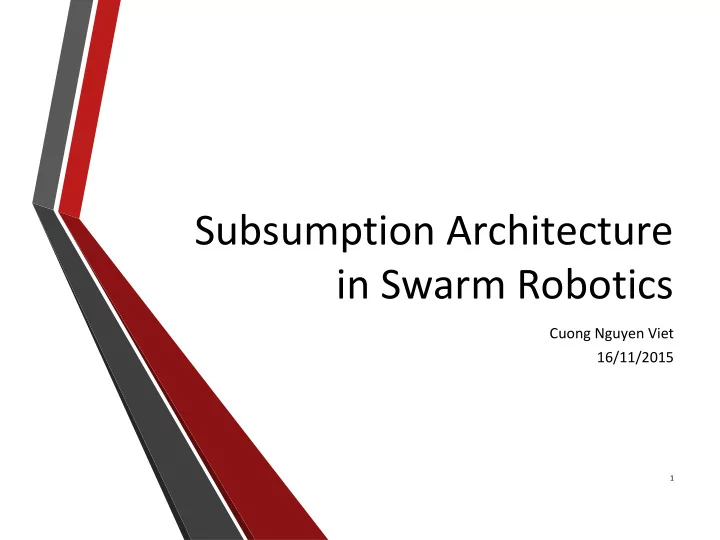

Subsumption Architecture in Swarm Robotics Cuong Nguyen Viet 16/11/2015 1
Table of content Motivation Subsumption Architecture Background ● Architecture decomposition ● Implementation ● Swarm robotics Swarm intelligence ● Subsumption architecture in swarm robotics ● Conclusion 2
Motivation Swarm robotics, motivated by collective behaviours of biology swarm, has desirable properties Effective approach for robot control architecture which emphasize emergence of behaviour from individual interactions 3
Subsumption Architecture Background Developed by Rodney Brooks at MIT in mid 80s Brooks argued that Sense-Plan-Act paradigm in traditional approach is not practical Brooks suggested layered control system in horizontal decomposition 4 Bio-inspired Artificial Intelligence: Theories, Methods and Technologies. Chapter 6. Figure 6.4. Figure 6.5.
Subsumption Architecture Decomposition Traditional approach: Sense-Plan-Act (SPA) approach ● Subsumption architecture: Inherent parallel system ● 5 Bio-inspired Artificial Intelligence: Theories, Methods and Technologies. Chapter 6. Figure 6.7 a)
Subsumption Architecture Decomposition (cont.) Layers of behaviour: Each layer is a pre-wired behaviour ● Higher level build upon lower level for ● complex behaviours The layers operate asynchronously ● 6 Bio-inspired Artificial Intelligence: Theories, Methods and Technologies. Chapter 6. Figure 6.7 a)
Subsumption Architecture Behaviour module Higher behavioural module subsume the competence of lower behavioural module 7 Bio-inspired Artificial Intelligence: Theories, Methods and Technologies. Chapter 6. Figure 6.6
Subsumption Architecture Features Key features: No knowledge representation or world ● model is used. The behaviours are organized in ● bottom up fashion Complex behaviour are fashioned from ● combination of simpler ones 8 Bio-inspired Artificial Intelligence: Theories, Methods and Technologies. Chapter 6. Figure 6.7 a)
Subsumption Architecture Implementation Navigation of a mobile robot An example from Brook (1986) ● Robot is a wheeled platform with circular ● array of sonar sensor 9
Subsumption Architecture Implementation (cont.) 10 Bio-inspired Artificial Intelligence: Theories, Methods and Technologies. Chapter 6. Figure 6.8.
Subsumption Architecture Implementation (cont.) 11 Bio-inspired Artificial Intelligence: Theories, Methods and Technologies. Chapter 6. Figure 6.9.
Subsumption Architecture Implementation (cont.) 12 Bio-inspired Artificial Intelligence: Theories, Methods and Technologies. Chapter 6. Figure 6.10
Subsumption Architecture Evaluation Strength Reactivity ● Parallelism ● Incremental design ● Weakness Inflexibility at runtime ● No explicit representation of knowledge ● 13
Swarm Robotics Swarm intelligence Studies of large collection of simple agents which can collectively solve problems that are too complex for a single agent Example: Particle Swarm Optimization ● Ant colony optimization ● 14 http://cir.institute/wp- content/uploads/2014/09/birds_vortex_800x450.jpg
Swarm Robotics Definition Simple interaction among robots in order to solve complex problem Group of 10 to 100 units 15 http://singularityhub.com/wp-content/uploads/2009/06/swarm- robots.jpg
Swarm Robotics Advantages Potential advantages Robustness ● Flexibility ● Scalability ● 16 http://softology.com.au/tutorials/boids/boids04.png
Swarm Robotics Classes 17 http://wyss.harvard.edu/staticfiles/ourwork/br/kilobots-350x233.jpg http://img.scoop. it/c1ZCYbe5UvCb3Y2pbfgHFjl72eJkfbmt4t8yenImKBXEejxNn4ZJNZ 2ss5Ku7Cxt
Swarm Robotics Control architecture The process of perceiving environment, reasoning and acting is defined by the robot’s control architecture Behaviour-based control is often used Methodology for adding and fine-tuning ● control Distributed and asynchronous robots without ● central control 18
Swarm Robotics Case study 1 Autonomous robots perform underwater mine countermeasures (UMCM) Two behaviour-based architectures were used for testing and implementation: subsumption and motor schema Behaviour Avoiding mines ● Avoiding obstacles ● Aggregation_Seperation ● 19 http://eia.udg.es/~busquets/thesis/thesis_html/img12.png
Swarm Robotics Case study 1 (cont.) 20 [2]. Figure 20. Subsumption architecture of a [2]. Figure 3. Motor schema architecture for mine mine hunting robot hunting
Swarm Robotics Case study 1 (cont.) 21 [2] Figure 21. 3 robots performing UMCM under subsumption architecture
Swarm Robotics Case study 1 (cont.) 22 [2] Figure 18. Robot swarm performing UMCM with motor schema
Swarm Robotics Case study 1 (cont.) Motor schema Subsumption Architecture + + Individual behaviour modular in Decision structure to pick correct nature behaviour + + Effective in controlling motion of Reactive to the environment individual robots - Inconsistent formation - - Lack of decision structure Unpredictability - may suffer from chaotic instability 23
Swarm Robotics Case study 1 (cont.) The motor schema approach is effective for controlling the motion of individual robots with a swarm The subsumption approach shows poor aptitude for swarm control. It lacks coordination except for collision avoidance 24
Swarm Robotics Case study 2 Exploration and foraging task is noncooperative - could be performed by one robot Box pushing task Robots cooperate in order to push a box to ● set location 25
Swarm Robotics Case study 2 (cont.) Hybrid control architecture Subsumption Architecture ● Motor schema Architecture ● 26 http://eia.udg.es/~busquets/thesis/thesis_html/img12.png
Swarm Robotics Case study 2 (cont.) 27 [4] Figure 2. Control based hybrid architecture
Swarm Robotics Case study 2 (cont.) The use of low-level communication give more coordination and robustness of interaction The hybrid control architecture is very efficient in cooperative task 28 [4] Figure 8. Evolution of the number of iteration according to N and Nc
Conclusion Subsumption Architecture yields great result - emergence of complex behaviours from simple ones. Pure subsumption is inadequate in solving certain tasks. Proposed hybrid architecture: cross subsumption, neural networks learning, global knowledge and planning 29
Reference [1] Floreano, D., & Mattiussi, C. (2008). Bio-inspired artificial intelligence: Theories, methods, and technologies . Cambridge, Mass: MIT Press. [2] Tan, Y.C. Synthesis of a controller for swarming robots performing underwater mine countermeasures. U.S.N.A. Trident Scholar project report ; no.328, 2004. URI: http://archive.rubicon-foundation.org/3590 [3] Rodney A. Brooks. (1985). A Robust Layered Control System for a Mobile Robot. Technical Report. Massachusetts Institute of Technology, Cambridge, MA, USA. [4] Adouane, L., Le Fort-Piat, N., "Hybrid behavioral control architecture for the cooperation of minimalist mobile robots," in Robotics and Automation, 2004. Proceedings. ICRA '04. 2004 IEEE International Conference on , vol.4, no., pp.3735-3740 Vol.4, April 26-May 1, 2004 30
Recommend
More recommend